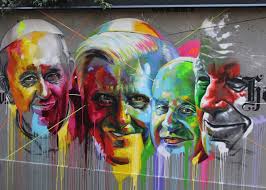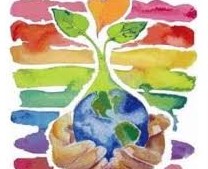Fourth Sunday of Advent
“Blessed are you among women” Lk. 1:40
“Mary: The Most Powerful Woman in the World.”
These are not the words of some Catholic newspaper, or some otherwise strongly religious publication. They are instead the title of the lead article, along with a cover painting of Mary, found in the recent issue of National Geographic magazine!
Stunning!
The article is written by Maureen Orth, a journalist who spent three years traveling throughout the world trying to understand more fully why Mary, the mother of Jesus, is so crucially important to millions of people.
Here are Maureen’s words: “Mary is everywhere: Marigolds are named for her. Hail Mary passes save football games. The image in Mexico of Our Lady of Guadalupe is one of the most reproduced female likenesses ever. Mary draws millions each year to shrines such as Fatima, in Portugal, and Knock, in Ireland, sustaining religious tourism estimated to be worth billions of dollars a year and providing thousands of jobs. She inspired the creation of many great works of art and architecture (Michelangelo’s “Pieta,” Notre Dame Cathedral), as well as poetry, liturgy, and music (Monteverdi’s Vesper for the Blessed Virgin). And she is the spiritual confidante of billions of people, no matter how isolated or forgotten.”
The author continues with a fact that many of us would find revealing: “Muslims as well as Christians consider her to be holy above all women, and her name ‘Maryam’ appears more often in the Koran than ‘Mary’ does in the Bible.”
Amazing!
But, why? Why is Mary so attractive that “praying for the Virgin Mary’s intercession and being devoted to her are a global phenomenon,” according to National Geographic?
What was it about this young girl that attracted and enticed even God – a God so enamored that an angel was sent to deliver the most revolutionary message ever?
I’ll suggest three possible reasons, with the reservation that there are surely a number of others.
First, Mary was a “being” person rather than a “doing” one. She was a “who-I-am” rather than a “what-I-do” type. She was a “listener” rather than an attention seeker.
The most admired American profile is often just the opposite. We like the classic go-getter, the overachiever. Doers get applause. “Being” people don’t. Consequently, we emphasize financial success and public achievement.
Now, with the proliferation of social media, we’re almost addicted to “telling it all” on Facebook and LinkedIn and Instagram, and all the rest.
Look at me. See what I’ve done. Check out my profile. Ooooh and ahhh over my “status.” Wow over my next picture.
That wasn’t Mary. She embraced simplicity. She seemingly experienced a deep joy through being alone with the Lord in meditation. She was a contemplative, in the same line as those in religious communities like the Trappists and the Poor Clares and others who spend the majority of their day in quiet prayer – something many of us would consider “useless.”
She wasn’t a preacher. She wasn’t an evangelist. She wasn’t an activist. Instead, Mary was one who paid attention, who reflected, who listened. All those Advent qualities.
She chose to perhaps be among the first to embrace the message later adopted by Francis of Assisi: “Preach the Gospel at all times, and when necessary, use words.”
Present. Open. Available. Receptive. Quiet. That’s the kind of person Mary was. And it was likely that collection of gifts that most enticed God, and so many people down through the centuries.
But I would also like to suggest another major gift of Mary’s personality – her life experience that has been repeated continuously by millions of people even to this day: Mary and Joseph’s journey to Bethlehem due to a census that is now being mirrored by millions who are being displaced from their ancestral homes; Mary and Joseph’s flight into Egypt to avoid the death threats of the tyrannical King Herod, just as today millions of refugees are doing the same; Mary’s loss of her child by an unjust state execution now paralleled by the disappearance and murder of beloved children under dictatorial regimes – the Herod’s of today.
Women, in particular, possibly find in Mary a sister to the lives of marginalized women in oppressive situations throughout the world – women who are without food, without clean drinking water, without housing, without education, without healthcare, without employment, without security from rape, without human rights.
To all of them, Mary stands up on their behalf and speaks words of hope to the neediest – such as these choice words from her great prayer, the Magnificat:
“ … O my God, … You have shown strength with your arm … You have put down the mighty from their thrones, and lifted up the lowly.”
Finally, Mary was a woman of profound faith. Despite all her heartaches, despite all the “swords of sorrow” that pierced her heart, despite having to stand beneath a cross and witness the horrific death of her son, Mary remained always a tower of strength, always the one who “believed that what was spoken to you by the Lord would be fulfilled.”
Today Mary is seen as the “God bearer.” She is the heart of the Gospel. She is the one who forces each of us to look at ourselves spiritually.
As one person in the National Geographic story says, “Everything is always rushing by so fast. We’re overwhelmed by media and caught up in the day-to-day. People don’t force themselves to look at what’s most important – the integrity of their soul.”
When asked what Mary meant to him, Pope Francis answered with one word, “She is my mama.”
With all this taken together, it’s no wonder National Geographic has titled her “the most powerful woman in the world.”
May our “mama,” the ultimate receiver of divine life, the one who is “blessed … among women,” help us all consider once again what is most important in life, and assist each of us in birthing anew the Child that falls from heaven into our arms … our hearts … our souls.
Ted Wolgamot, Psy.D.
11809194.1 12/15/15



